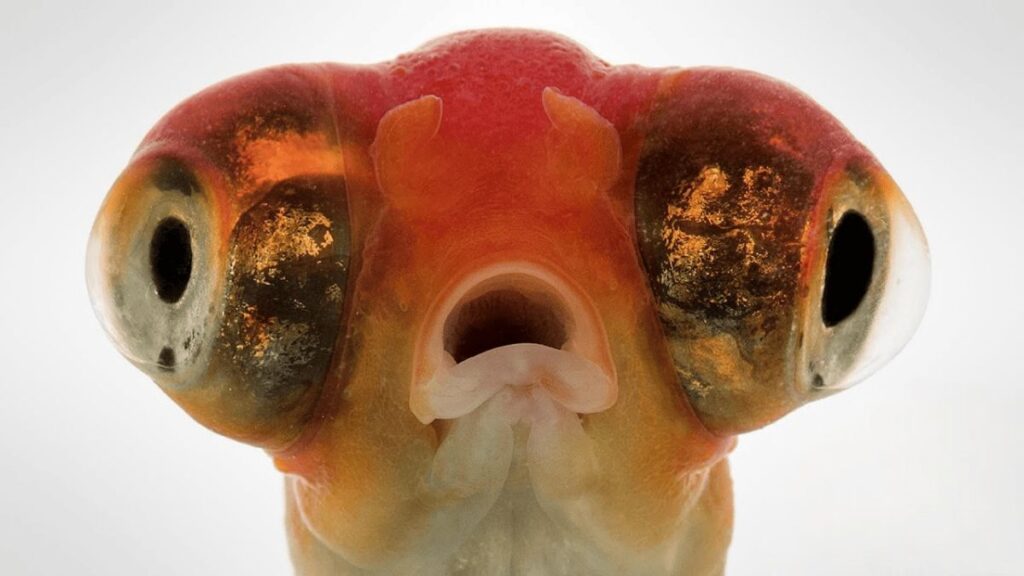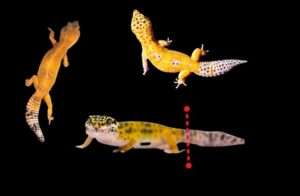
If you had pet fish as a kid, chances are it was a goldfish.
Hundreds of millions of them are sold in the US each year.
And it’s easy to see why, with their shimmering scales and swirling tail.
So calming to watch.
And that’s what first led people in China to breed them more than a thousand years ago.
But as it turns out, beauty wasn’t the only thing goldfish had going for them.
They also had lots of really strange biological traits that made them incredibly resilient.
That resilience helped them spread across the planet and into bedrooms everywhere.
And in an unfortunate twist, we’re now breeding away the very qualities that once made the goldfish nearly invincible.
Around 265 CE, red, shimmering goldfish first appeared in lakes in southern China.
They were a hybrid of the crucian carp and the common carp, both rather standard-looking as far as fish go, with olive or gray coloured bodies.
But as evolutionary chance would have it, some of these hybrids had glistening red scales instead.
That sheen came from guanine, the same molecule that allows chameleons to change colors and is sometimes used in cosmetics to make them reflect light.
Their lustrous scales made goldfish a prized catch.
Quite literally.
Monks kept goldfish in ponds on the monastery, and they were regarded as sacred because of their beauty.
But by the 14th century goldfish had moved out of the pond and into small porcelain bowls.
This was the start of breeding goldfish for their looks.
Soon, silver-white, golden-yellow, and tortoiseshell varieties were thriving in their indoor homes.
Now one reason there were quickly so many types is that goldfish are what are called allotetraploids.
That means their genome has four sets of chromosomes, unlike most animals, which have two sets.
Somewhere between 8 and 14 million years ago, the goldfish’s ancestor went through an event called whole genome duplication.
Essentially, the ancestor fish inherited the usual one set of chromosomes from each of its parents, and those two sets combined to make its genome.
But then that entire genome was duplicated.
Suddenly, the ancestor fish had an extra copy of its genetic instructions sitting around.
And those two copies evolved separately.
That means every time a new mutation occurred in one copy, the old variation of the gene stayed behind in the other.
Essentially, goldfish could keep gaining new physical traits, without losing the old ones.
By the sixteenth century, several varieties of those selectively bred goldfish were being transported across the ocean from China to Japan.
There, goldfish sellers looking for customers would cart the creatures around on summer festival days in wooden tubs.
Despite the sweltering temperatures outside, the fish usually managed to keep their cool.
And that’s probably thanks to their amazing ability to withstand a wide range of temperatures, anywhere from 0 to 43 degree celsius.
Considering the fact that most freshwater fish are comfy only between 15 and 24 degrees, this made the goldfish an ideal species to lug around in less than ideal conditions.
In fact, at the upper end, they had some of the best heat tolerance of all fish.
Fish in general are sensitive to water temperatures because they’re poikilotherms.
That means their internal body temperature, and therefore all the processes that go on in there, are dictated by the environment.
As luck would have it, goldfish were particularly good at adjusting those internal processes to different temperatures.
Take the ability to turn fuel into energy, also known as metabolism.
Aerobic metabolism, which requires oxygen, is more effective at turning fuel into energy than metabolism that happens without the gas.
But if temperatures get too far above or below a certain optimum temperature, aerobic metabolism stalls.
At high temperatures, that’s partly because the heart can’t beat fast enough to pump the needed oxygen around the body and into cells where that metabolism takes place.
But as goldfish got used to occasionally dealing with hot temperatures, their hearts adapted to beat at a slower rate under typical circumstances than that of most cold-water fish.
That allowed their heart rates to go up when temperatures rose, without beating so fast that it messed up the rhythm.
And in cold water, goldfish could change the balance of fatty acids in the cell membranes of their brains, muscles and intestines to allow greater nutrient exchange with their blood when their hearts were pumping slower.
For example, at near freezing temperatures, goldfish had more unsaturated long-chain fatty acids in their intestinal cells.
Although the mechanism isn’t well studied, some scientists have proposed that this made it easier for amino acids to pass between the intestines and the blood, where they could be used for growth, repair, or other bodily functions.
Those adaptive superpowers would come in handy not just when goldfish were being carried around for sale, but also in their journey around the world.
By the eighteenth century, goldfish had ventured as far as Europe.
The fish were brought there on ships by merchants who had picked them up alongside other goods during trade deals with the Chinese.
And again, it was the goldfishes’ hardiness that saw them through those long sea voyages.
Aboard the ship, the fish would quickly use up whatever oxygen was in their sealed storage crates.
But as it turns out, goldfish can live with almost no oxygen.
This ability probably evolved to get the fish through long winters in ponds capped with ice.
And the primary way they do it is by dealing with the harmful compounds that get made when creatures are starved of oxygen.
Like most vertebrates, goldfish can switch how they burn fuel from doing it with oxygen, or aerobic respiration, to without, or anaerobic respiration.
The problem is, anaerobic respiration creates lactic acid that needs to be broken down by cells before it leaves the body.
And that can quickly build up and kill most species.
But goldfish can convert lactic acid into ethanol that just leaks out harmlessly through the gills.
They accomplish this using a version of the enzyme pyruvate decarboxylase, which breaks down lactic acid through fermentation.
It’s similar to how brewer’s yeast breaks down sugars to make alcohol.
In the stagnant, low-oxygen tanks where goldfish found themselves living, it was an essential survival skill that almost no other fish had.
After goldfish became popular pets in Europe, they made their way to the US in the mid 1800s.
One marketing ploy, in particular, put literally thousands of goldies in homes across America.
In a publicity stunt, the newly-formed Fisheries Commission promised to send people a pet goldfish if they wrote a letter to their local congressperson.
The campaign was so popular that by 1894, they had given out more than 20,000 fish.
And the commission didn’t need to rely on imports to produce those big numbers.
It was easy to raise thousands of goldfish thanks to their prolific breeding habits.
Female goldfish can lay as many as 40,000 eggs every year.
If it sounds like a lot, that’s because it is!
The betta fish, another popular pet, lays closer to 100 eggs.
And those breeding habits didn’t just make the goldfish appealing to marketers.
It also caught the eye of scientists looking for animal models that they could get in large numbers.
Goldfish were particularly useful for studying evolution.
They had a wide range of physical features, and they were easy to breed so you could see many generations over a short time.
But there was something else about goldfish that made them particularly appealing to researchers: they’re basically sponges.
Because of the large surface area of their gills and their many blood vessels, goldfish are unusually good at absorbing substances.
Which made them great for things like testing toxicity.
One of the first studies to use goldfish as an aquatic canary in the coal mine was in 1917, when a zoologist named Edwin Powers was researching the toxicity of household chemicals.
The goldfish were put in tanks of water containing everything from lithium chloride, which was used to treat bipolar disorder, to cadmium chloride, a colorant used in oil paints.
Powers noted the concentration of the substances and how long the fish lived.
He plotted the results on a graph, with survival time on the y-axis and concentration of the solution on the x-axis.
And the part of the graph where fatality increased most quickly was the threshold of toxicity.
But Powers sometimes had a hard time identifying that threshold because some of the fish would tough it out for so long.
Since those early experiments, goldfish have been used to study the toxicity of everything from growth hormones to insecticides.
In 2008, for example, scientists used goldfish to test the effects of potentially cancer-causing substances downstream from a textile dyeing factory.
This time, they weren’t looking at how many fish died, but how those substances in the water damaged the fish’s DNA.
And no other fish was better suited to absorb a high volume of that stuff and live than goldfish.
From spending their days in wooden troughs carted around the streets of Japan to small bowls in kids’ bedrooms, goldfish have managed to survive some pretty unpleasant conditions thanks to their biology.
But as they’ve become more popular as pets, breeders around the world have created weirder and more exotic varieties.
Today, there are more than 200 kinds of goldfish with all sorts of striking features.
I mean, look at this Celestial Eye Goldfish.
His huge bulging eyes point skyward.
And this Tosakin, with its massive, fan-like tail.
But the quest for the most spectacular varieties has come at a cost.
Many of the so-called “fancy” varieties of goldfish have lost some of their amazing survival skills.
That fabulous tail, for example, is pretty useless at propelling the fish through water, which means these goldies have a hard time controlling where they’re going.
And those googly-eyed stargazers?
Their retinas slowly break down from constantly staring up at the light, leaving them practically blind.
But on an even deeper level, breeding fish from the same gene pool has meant there’s been a big loss in the genetic diversity of goldfish.
Many of the fancy varieties are prone to diseases like swimbladder disorder.
That’s where the pouches of air that control the fish’s buoyancy have shrunk or ballooned, meaning they either float on the surface or sink to the bottom of the tank.
Basically, their internal organs have been squeezed to fit within whatever aesthetic body shape a breeder might want.
Low genetic diversity also makes a species more likely to be wiped out if a particularly nasty disease takes hold or their environment suddenly changes.
Which might not be so bad for goldfish if we’re keeping them safe and sound inside well-kept tanks.
But still, it seems a shame that many goldfish have lost the hardiness that allowed them to conquer the aquarium, and the world, in the first place.

![Moon Jellyfish has [ Hidden Secrets ] You don't know moon jellyfish](https://spaceupper.com/wp-content/uploads/2022/11/1-1-300x169.jpg)









